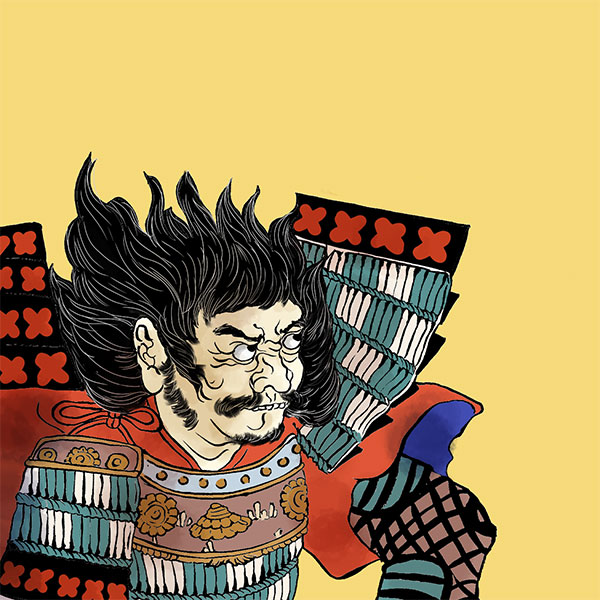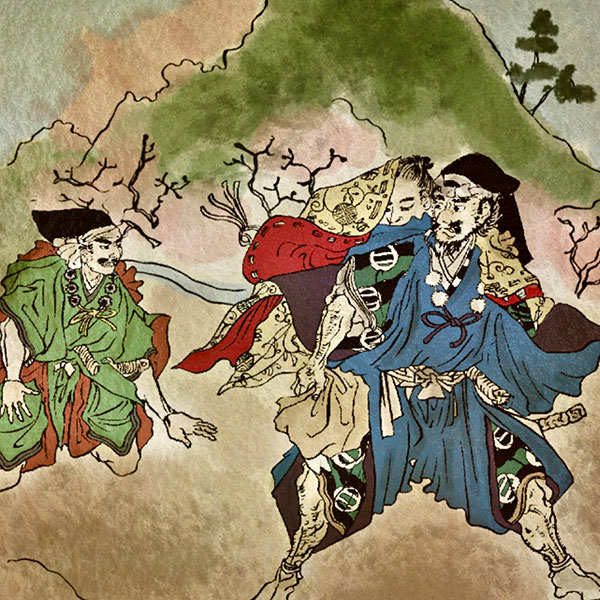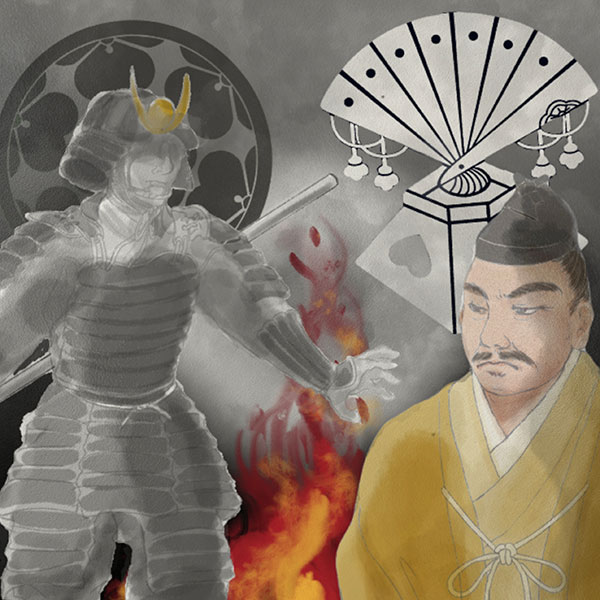Miyoshi trio (1/2)Miyoshi family triumvirate

Miyoshi trio
- Article category
- biography
- name
- Miyoshi Sanjinshu (year)
- place of birth
- Tokushima
- Related castles, temples and shrines
- related incident
After the Onin War, Japan entered an era called the Sengoku period. In the middle of the Sengoku period, just before the rise of Oda Nobunaga, Miyoshi Nagayoshi ruled Kyoto. The Miyoshi family ruled from Shikoku to half of the Kinki region and was the largest daimyo in Japan. However, misfortune continued for the Miyoshi family, and Nagayoshi also passed away. It was the Miyoshi Sanninshu who guided the Miyoshi family who had no leader. This time I would like to take a look at the Miyoshi Sanninshu.
The Miyoshi family and the Kyoroku/Tenbun War
Immediately after the Onin War, Masamoto Hosokawa led politics in Japan. However, when Masamoto Hosokawa was assassinated, Masamoto's adopted children fought over the position of head of the Hosokawa family (Ryohosokawa Rebellion).
Mr. Miyoshi served the Hosokawa family, which was in conflict with each other. The Miyoshi clan originated from Miyoshi District, Awa Province (present-day Miyoshi City, Tokushima Prefecture). He established his base in Awa Province and Sanuki Province (present-day Tokushima Prefecture and Kagawa Prefecture) and began to gain strength.
Motonaga Miyoshi became the head of the Miyoshi family. Motonaga defeated Takakuni Hosokawa and quelled the conflict within the Hosokawa family. However, Motonaga Miyoshi was at fault. His master, Harumoto Hosokawa, was not happy with Motonaga Miyoshi. Harumoto Hosokawa, who hated him, decided to eliminate Motonaga Miyoshi. However, Harumoto Hosokawa was not strong enough to eliminate him. There, Harumoto asked Shonyo of Yamashina Honganji Temple for help, and Motonaga Miyoshi was forced into the Ikko Ikki and committed suicide. (“Kyoroku Tenbun no Rebellion”)
Motonaga Miyoshi committed suicide in Sakai, but immediately before his death, his children and wife fled to Shikoku. The eldest son of Motonaga was Nagayoshi Miyoshi. A member of the family who supported Nagayoshi from the beginning was Nagaitsu Miyoshi, one of the Miyoshi Sanninshu.
Miyoshi trio
- Nagayasu Miyoshi
- The year of Nagatsu Miyoshi's birth is unknown, but his father, Naganori Miyoshi, was killed in the Battle of Tojiin, so it is thought that Nagatsu Miyoshi was born before 1520. When Motonaga Miyoshi died and Nagayoshi Miyoshi became the head of the Miyoshi family at a young age, Nagaitsu Miyoshi supported Nagayoshi as the elder member of the family. Many people died in the Miyoshi family due to internal conflicts within the Hosokawa family. Therefore, the younger generation, such as Nagaitsu Miyoshi, had to take the lead.
Nagayoshi Miyoshi became the head of the Miyoshi family. When Nagayoshi returned to Kinai from Shikoku, he served Harumoto Hosokawa, Kanrei. While serving Harumoto Hosokawa, the Miyoshi family pursued its own expansion path, expanding its territory from Settsu Province to Harima Province (from Osaka Prefecture to southwestern Hyogo Prefecture) in addition to Shikoku.
Motonaga Miyoshi passed away, and the Miyoshi family was once on the verge of decline. However, with Nagayoshi Miyoshi becoming the head of the family, the Miyoshi family gradually expanded. There was someone who looked at Nagayoshi Miyoshi bitterly, Masanaga Miyoshi, who was a member of the same Miyoshi clan and served under Harumoto Hosokawa. - Souichi Miyoshi
- Masanaga Miyoshi served the Kanrei Harumoto Hosokawa as a member of the Miyoshi clan. However, he did not get along well with the head of the family, Motonaga Miyoshi (father of Nagayoshi Miyoshi), and often slandered his lord, Harumoto Hosokawa. As a result, Motonaga Miyoshi was shunned by Harumoto Hosokawa and was forced to commit suicide in Sakai. Masanaga Miyoshi also had a bad relationship with Motonaga Miyoshi's eldest son, Nagayoshi Miyoshi, who committed suicide. Miyoshi Nagayoshi presses Harumoto Hosokawa for permission to pursue Masanaga. Since Harumoto Hosokawa did not respond to this request, Nagayoshi Miyoshi took his own initiative and raised an army to hunt down Masanaga Miyoshi.
Souichi Miyoshi, who later became one of the Miyoshi Sanninshu, was born as the eldest son of Masanaga Miyoshi.
Miyoshi Nagamasa resisted Miyoshi Nagayoshi along with his children Souichi and Tamezou, and the head of the family, Harumoto Hosokawa. However, Masanaga Miyoshi was attacked by Nagaitsu Miyoshi and others and was defeated. Even after their father, Masanaga Miyoshi, was killed, the brothers Muneki and Tamezo were in conflict with Nagayoshi Miyoshi. However, as Nagayoshi Miyoshi gained more momentum, he became irresistible, and by the first year of Eiroku (1558), all his brothers had become Nagayoshi Miyoshi's retainers. Because the brothers had served the Kanrei Hosokawa family for a long time, they had connections with feudal lords in the Kinai region, and they valued this and used it highly.
In this way, Souichi Miyoshi, the son of Masanaga Miyoshi, who was a political enemy, came to serve as a retainer of Nagayoshi Miyoshi, who ruled half of the Kinai region. - Tomomichi Iwanari
- Miyoshi Nagayoshi expelled his lord, Harumoto Hosokawa, and took control of half of the Kinai region from Shikoku. However, as a result of rapid expansion, there was a shortage of manpower. Miyoshi Nagayoshi discovers human resources in the Kinai region, which he directly controls. For example, the brothers Hisashi Matsunaga and Nagayori are representative, and Tomochi Iwanari, one of the Miyoshi Sanninshu, was one of them. By proactively recruiting locally (in the Kinai area) to fill the shortage of human resources, they were able to create a group of vassals that was not limited to the Miyoshi family that had existed up until then.
Miyoshi Nagayoshi was supported by a group of talented vassals. The Miyoshi clan was able to control the eastern half of Shikoku (Awa Province, Sanuki Province) and the western half of Kinai (Settsu, Kawachi, Izumi, Yamato, Tanba, Harima). At the time, he was one of Japan's leading daimyo.
Miyoshi Nagayoshi became a ruler of Japan, mainly in the Kinai area.
The origins of Tomomichi Iwanari, who became one of the Miyoshi family vassals, are unknown. However, in 1550, his name began to appear as a vassal of the Miyoshi family, and he rose to prominence as a member of the magistrates, increasing his status within the Miyoshi family.
The height of the Miyoshi family
The influence of the Miyoshi family during the Eiroku era (1558) extended from the western half of Kinai to the eastern half of Shikoku. He is the biggest daimyo in Japan.
The shogun Yoshiteru Ashikaga disliked Nagayoshi Miyoshi, who had acquired such power. Nagayoshi Miyoshi and Yoshiteru Ashikaga often fight.
However, in 1561, Miyoshi Nagayoshi and Shogun Yoshiteru Ashikaga, tired of fighting, reconciled. As a proof of reconciliation, he invited Yoshiteru Ashikaga to the Miyoshi family's mansion in Kyoto and held a drinking party (Shogun Onari). It is considered an honor to invite the general to your mansion and hold a banquet.
This was the moment when the Miyoshi family, which had emerged from Shikoku, reached its peak.
Nagaitsu Miyoshi will be attending this banquet as the head of the Miyoshi family. Choitsu led the clan from the beginning of Miyoshi Nagayoshi's rise to supremacy, and became the highest-ranking member of the Miyoshi family, excluding Miyoshi Nagayoshi and Yoshioki's father and son. He also became an elder among the Miyoshi family, holding the official rank of Junior Fourth Rank, Shimohinaga no Kami.
The death of Nagayoshi and the rise of the Miyoshi Sanninshu
The Miyoshi family reconciled with Shogun Yoshiteru Ashikaga and ruled the country centered on the Kinai region. However, the prosperity of the Miyoshi family did not last long. From the time Yoshiteru Ashikaga visited the Miyoshi family's mansion, the Miyoshi family began to decline.
Starting in the same year that Yoshiteru Ashikaga was invited to the Miyoshi family's residence, Nagayoshi Miyoshi's younger brothers who had supported him passed away one after another. Furthermore, in 1563, Nagayoshi's biological son Yoshioki Miyoshi also died young at the age of 22. Nagayoshi Miyoshi had only one child, Yoshioki Miyoshi. It is said that Nagayoshi lost Yoshioki and left his body broken. Nagayoshi, who had no heir, adopted his nephew Yoshitsugu Miyoshi to inherit the Miyoshi family.
In 1564, the head of the Miyoshi family, Nagayoshi Miyoshi, also passed away. The Miyoshi family is inherited by Yoshitsugu Miyoshi, who was adopted as an adopted son. Assisting this young Yoshitsugu were Nagaitsu Miyoshi, Soei Miyoshi, and Tomomichi Iwanari, who came to be known as the Miyoshi Sanninshu. Miyoshi Nagaitsu was an elder statesman who supported the Miyoshi family from the time the deceased Miyoshi Nagayoshi became the head of the family, and Miyoshi Muneyoshi served the former lord Hosokawa Harumoto when he was at odds with Nagayoshi, so he served as a pipe to the feudal lords of the Kinai region. Therefore, the negotiator, Tomomichi Iwanari, who was a former magistrate, led the Miyoshi family by coordinating the group of retainers of the Miyoshi family. These three people were referred to as ``Sanninshu'' in the ``Kotetsugukyoki'' and ``Tamonin Nikki,'' so they were called the Miyoshi Sanninshu from that time.
The Miyoshi family's empire, centered on the Kinai area, would be managed by the Miyoshi trio.
Eiroku Incident
Miyoshi Nagayoshi, who became a ruler of Japan, passed away. The Miyoshi family has Yoshitsugu Miyoshi as the head of the family, supported by the Miyoshi Sannin.
- related incident

- WriterTomoyo Hazuki(Writer)I have loved history and geography since my student days, and have enjoyed visiting historical sites, temples and shrines, and researching ancient documents. He is especially strong in medieval Japanese history and European history in world history, and has read a wide range of things, including primary sources and historical entertainment novels. There are so many favorite military commanders and castles that I can't name them, but I especially like Hisashi Matsunaga and Mitsuhide Akechi, and when it comes to castles, I like Hikone Castle and Fushimi Castle. Once you start talking about the lives of warlords and the history of castles, there's a side of you that can't stop talking about them.




